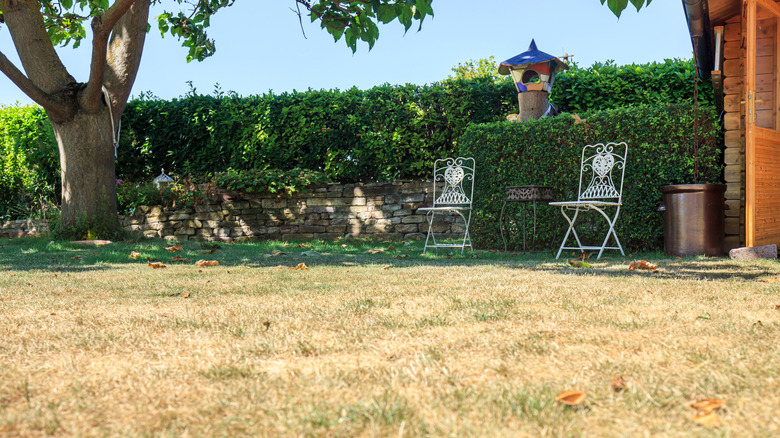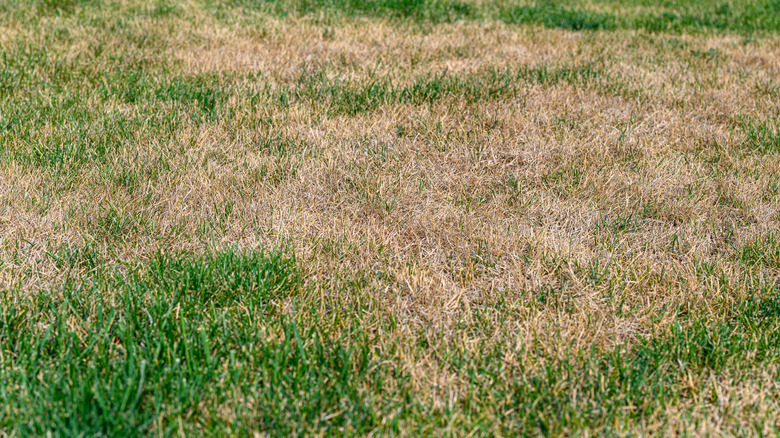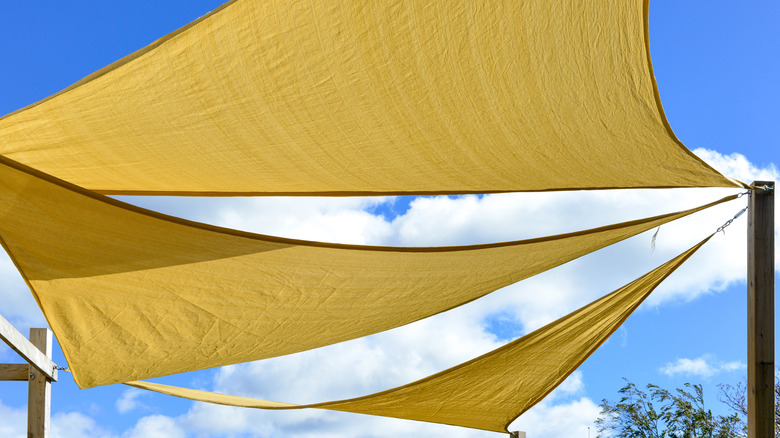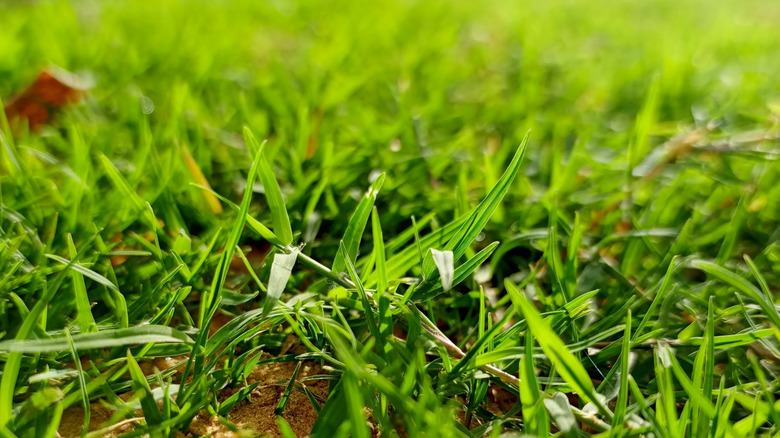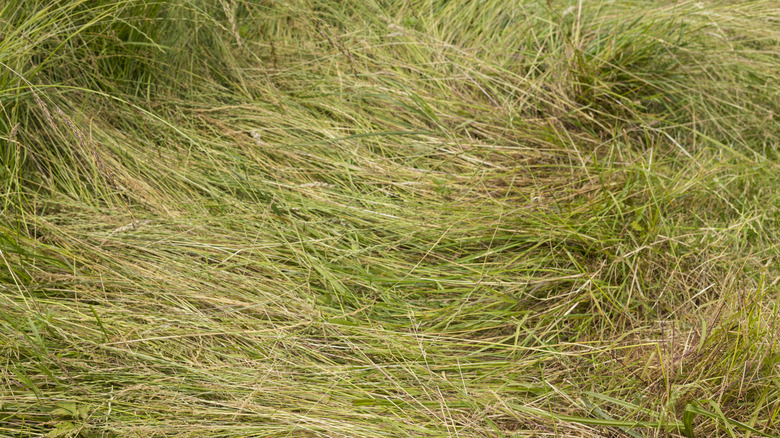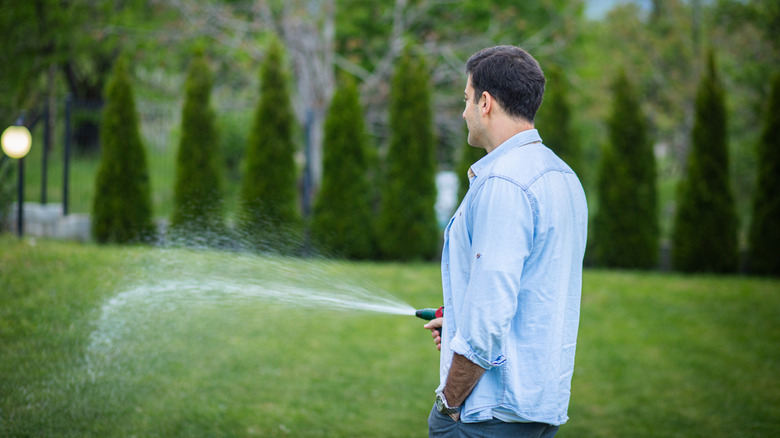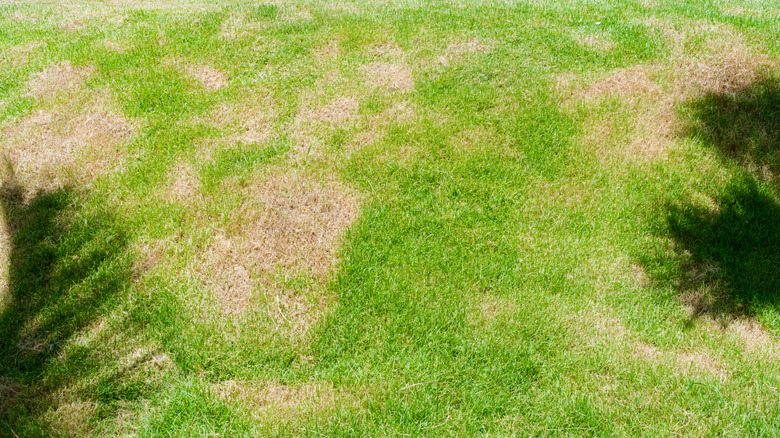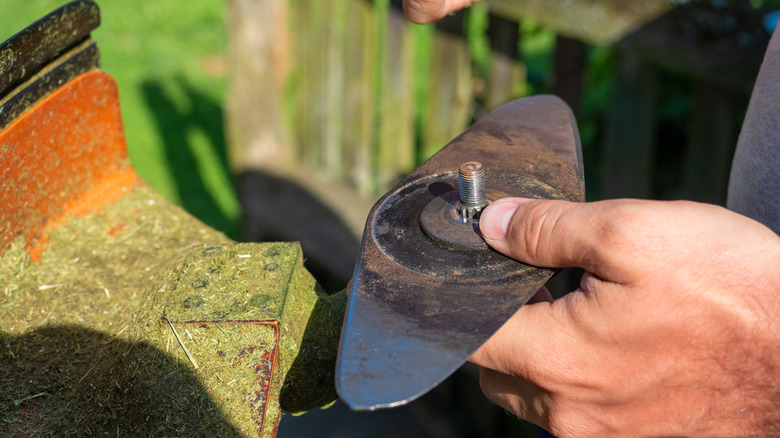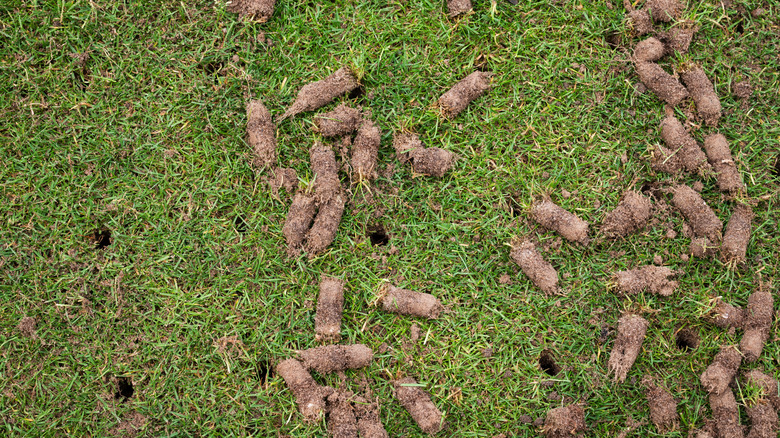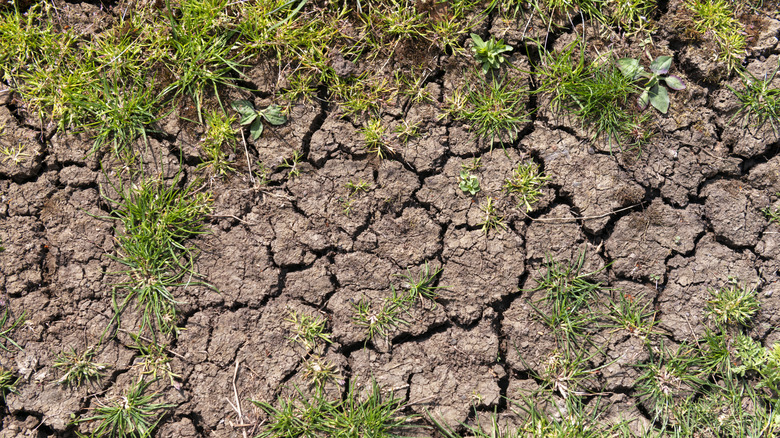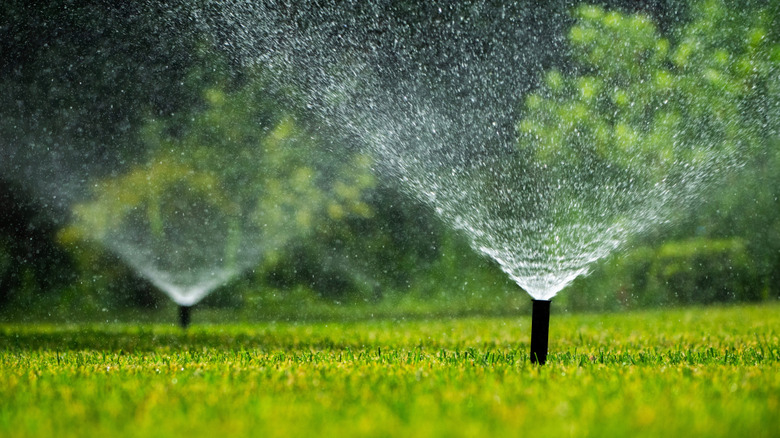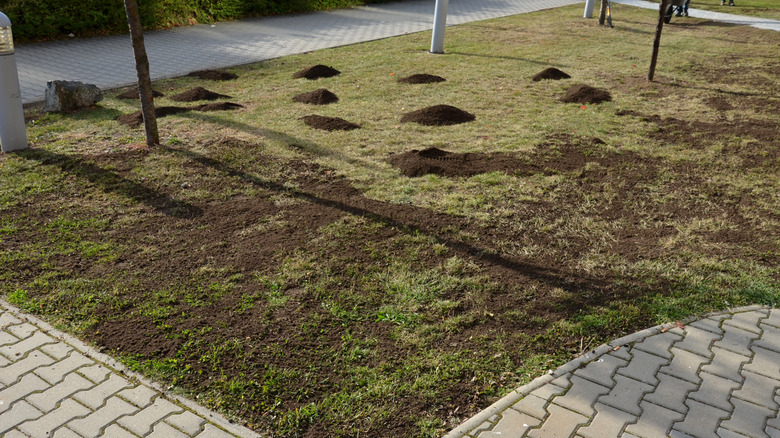4 Signs That Heat Stress Is Getting To Your Lawn And What You Can Do About It
We may receive a commission on purchases made from links.
When summer hits its peak and the temperatures soar, your lawn can start to show signs of serious heat stress. Heat stress in lawns can sneak up quickly during long dry spells or sudden heat waves, and if you're not paying close attention, you might miss these warning signs! Sure, brown and patchy grass and dry, cracked soil are some of the most common tells, but there are others that might sneak up on you. If you know what to look out for, there's less of a chance of your entire yard dying in a major heat event. The good news is that whatever happens, there are things you can do to help your lawn recover, or better yet, prevent heat stress from even happening in the first place.
For each heat stress warning sign, there are plenty of simple, smart ways to take action before the damage becomes too hard to fix. Even if you're new to lawn maintenance, with a little know-how, you can keep your yard looking healthy and green, even when the weather is working against you.
Sign: The grass is turning brown or straw-colored
One of the first signs that your lawn is under heat stress is major discoloration. This is especially true if you have a lawn full of cool-season grass, as it will lose its green color in hotter temperatures and begin turning tan in some patches, or yellowish in others. Sometimes, the entire lawn will turn. Cool-season grasses are the likes of Kentucky bluegrass, perennial ryegrass, and tall fescue, among others. These grasses do best from around 68 degrees Fahrenheit to 77 degrees Fahrenheit. If the temperature rises above 87 degrees Fahrenheit for a sustained period of time, then the grasses will struggle to photosynthesize carbon dioxide (CO2), which keeps them healthy. Instead, long periods of higher temperatures lead them to use oxygen (O2). This jumpstarts a process called photorespiration, which means the grass is using energy, instead of making energy. This is what leads to its color loss and eventual death.
In this weakened state, the brown grass could also be caused by destructive cinch bugs, which love water-stressed lawns. Look for them around the edges of the dry patches. You'll typically find them eating the blades of the grass, not its roots. They are tiny black insects with white wings. In their smaller state, they look a bit like little roaches. The solutions mentioned below, plus the occasional use of pesticides, can get rid of cinch bugs.
Short-term solution: Provide emergency shade
In a heat stress emergency, the first thing you should do is put up emergency shade over particularly damaged patches of lawn. Removing them from the scorch of direct sun can assist in giving the grass time to recover. Just be sure the cover itself isn't directly touching your yard, so there is still some airflow. This Tobengda Greenhouse Sun Shade with Grommets can be temporarily installed over grass, flowerbeds, and even potted plants alike to give them a break. If you don't have anything to fasten the shade to, try a pop-up tent like the Amazon Basics Outdoor Pop Up Tent instead.
In the long term, more permanent solutions typically include landscape changes. "Growing the best trees for shade is a long-term goal — I often call them 'trees for posterity,'" Blythe Yost, CEO of online landscape design practice Tilly, told Homes & Gardens. "It will take many years for shade trees to reach their full potential, but it is important for us to include them in our garden for the shade they provide today and the potential shade they will offer to others in years to come." Though it might take generations for their shade to reach its full potential, trees are always worth the investment. Oaks, including white oak (quercus alba) and live oak (quercus virginiana), are good choices, as is the faster-growing Eastern redbud (cercis canadensis).
Long-term solution: Swap out for warm-season grasses
As mentioned, cool-season grasses just can't thrive in climates that are extremely warm for extended periods of time. While a New Englander might not experience many months above 87 degrees Fahrenheit, those living in Texas or Florida definitely will. For this reason, those living in a USDA growing zone with a higher number should consider swapping to a warm-season option like Bermudagrass, St. Augustinegrass, or even buffalograss for longer-term success. These grasses have a higher chance of surviving during the sweltering summer months. In fact, picking the right kind of grass is a hack you can steal from golf courses for a better lawn.
If you feel worried about your new warm-season lawn going brown in the winter, there is still a way around it: overseeding with ryegrass in the fall. "This is the best time of year for seed growth and seeding at this time does not compete with pre-emergent herbicides that are typically applied in the spring to prevent summer weeds and may interfere or inhibit grass seed germination," Ryan Walts, franchise training coordinator and business coach at Lawn Squad, told House Digest exclusively, when discussing the grass seed that's great for overseeding. This way, your lawn will have a sort of two-for-one approach happening, in that it has grass seed that can withstand hot summer days and cooler winter nights, too.
Sign: Your footprints remain visible for long periods
Another glaring sign that heat stress is getting to your lawn is an overall lack of bounce-back ability. You'll notice this is the case if things like your footprints, wheelbarrow marks, or even your pet's pawprints linger long after what made the impression is gone. This is a sign that the blades haven't been getting enough water for some time now and your lawn needs some urgent attention.
The first time you notice this happening, avoid walking on the grass as much as possible from then on, as it can actually make the damage worse. This is because the grass blades are already stressed and very brittle due to dehydration. So, any additional pressure from foot traffic or lawn equipment can crush the stems or compact the soil even further. This makes it harder for water and air to reach the roots during the emergency restoration processes described below. Giving it time and space to bounce back will help prevent long-term damage and encourage healthy regrowth.
Solution: Water deeper and less often
To help your lawn recover from this stage of heat stress, it's important to water it the right way. Instead of watering every single day (which might feel tempting as a solution!), grass in severe heat stress needs deeper, less frequent sessions, instead. This encourages the grassroots to grow deeper down into the soil, where they can better access moisture even during dry spells down the line. A shallow watering routine only trains grass to rely on surface-level moisture, making it more vulnerable during future heat waves. By letting the water soak in thoroughly, you're helping the grass build resilience and bounce back faster from stress. To make sure the water doesn't all burn off before sinking in, or cause the grass to scorch, schedule your watering in the early hours of the day. Typically between 4 a.m. and 8 a.m. is best during this time of year.
Then, to make sure these sessions are actually working the way you want them to, purchase a moisture meter for your lawn. Something like the XLUX Soil Moisture Meter ensures you can actually check if your lawn's root zone is getting saturated with water. Sometimes, you think you watered deeply, but in reality just the top inch or so is moist. By checking the moisture levels after the first few sessions, you will have the information you need to make decisions about adjusting your watering strategy.
Sign: There are thinning or bare spots
If your lawn is starting to look patchy, with sections of dry, tan grass interrupted by clumps of green, it may also be a sign of heat stress. Grass that's exposed to prolonged sun and high temperatures can die back in those areas, especially when it's unable to retain enough moisture. These thinning spots are common in lawns with poor drought tolerance and often appear first in the sunniest parts of your yard.
To make things worse, these thinned out areas can also mean you have a grub problem. When soil dries out and grass stops growing, it becomes easier for grubs (little beetle larvae that feed on grass roots) to set up shop. Their damage can make heat-stressed grass look even worse, turning already vulnerable patches into full-blown bare spots. Pulling back a small section of turf can help reveal whether grubs are lurking just beneath the surface, or if it's just the sun that's doing it. If you don't have grubs, the following tips should solve the issue. If you do, you might need to use a little insecticide if it's a major issue, although restoring the overall health of your lawn typically does the trick for small amounts.
Short-term solution: Raise your mower blade and adjust mowing patterns
Mowing too low can directly exacerbate bare patches by scalping the lawn, because grass blades are needed for the photosynthesis process. The less photosynthesis that occurs, the less energy the grass has to maintain its health. So, it's best practice to increase the mower's blade height. Adjust your lawnmower blade to a high position, which typically leaves your grass about 3 or 4 inches long. This also means the grass can provide a little bit of shade to its own roots (as you can't put your entire lawn under a canopy, realistically) and retain more of the water that you give it.
After adjusting your mower's blade, you also need to consider what your mowing schedule looks like. If you have a warm-season grass in your yard, you can mow regularly throughout the summer. These grasses are typically thriving in the heat and can be cut back (albeit still high) weekly. If you still have a cool-season grass, consider skipping mowing during a major heat event, as not to damage the grass. Keep an eye on the weather, and if the temperature consistently dips back below 87 degrees Fahrenheit and you don't see any visible death in the grass, resume your typical mowing schedule.
Long-term solution: Aerate in before next summer
One of the best ways to protect your lawn from future heat stress is to aerate it in the spring or fall. Aeration helps loosen compacted soil. When the soil is compacted, it becomes harder for nutrients to reach the grassroots. This sets the stage for dryness, shallow root growth, and bare patches — all things that make your lawn more vulnerable when hot weather rolls around! By aerating in the offseason, you're giving your grass time to expand its root system and better absorb moisture throughout the cooler months, so it's more resilient in the summer. Aerating also opens up the soil surface, which means that if you choose to overseed or fertilize afterward, those materials will make better contact with the soil and work more effectively.
The best method is core aeration, which uses a machine to remove small plugs of soil from the ground. These plugs are typically about 2 to 3 inches long and spaced a few inches apart. You can typically rent an aerator from a local home improvement store, or purchase a smaller one online, like the MEIIOFS Lawn Aerator. An aerator is one of the essential lawn tools for healthy green grass. For the best results, mow your lawn and give it a good watering a day or two beforehand to soften the soil. After aerating, leave the soil plugs on the surface. This is because they'll dissolve naturally and add nutrients back into the lawn.
Sign: The soil is cracked or very hard
One of the clearest signs that your lawn is under severe heat stress is cracked, rock-hard soil. During long stretches of hot, dry weather, the moisture in the ground evaporates quickly, causing the soil to shrink and tighten. This not only makes it tough for water to soak in during irrigation or rain, but it also puts extra pressure on your grass. Roots can't grow freely in compacted soil, and with limited access to water and nutrients, your lawn starts to show signs of serious stress.
So, how can you tell if your soil is too hard? One easy trick is the screwdriver test. Take a regular screwdriver and try to push it into the ground. If it slides in easily, your soil is still in decent shape. But if it's difficult to get the tool more than an inch or two deep, your lawn is struggling. Another thing to watch for is soil cracking. While your yard might not have large splits like a mud flat in a dry riverbed (although it might!), there will still be signs. Walk around the edges of your lawn, especially near any sidewalks, your driveways, or your garden beds. If you notice that the soil has pulled away from these hard surfaces or small fissures have formed, it's a clear signal that the ground is excessively dry and shrinking fast.
Short-term solution: Rehydrate with repeated, light watering until there is no runoff, and use soil wetting agents if needed
If the soil is this dry and compacted, water can't properly soak in. It just runs off the surface instead. To fix this, start with repeated, light watering sessions to allow the water time to gradually penetrate hardened soil. This is opposite to the previously mentioned strategies, but works well to solve this specific problem with soil. Start by watering for just a few minutes, then pause to let the water soak in. Once the surface begins to soften, you can gradually increase the watering time. This technique helps prevent waste and ensures the water gets where it's needed: down to the root zone.
Sometimes in this situation, your soil might be so dry that it actually starts to repel water. It will need a little extra help to soak in. That's where soil wetting agents come in. These products contain both hydrophilic and hydrophobic molecules, the dual nature of which helps water spread more evenly across and into the soil, breaking the surface tension that causes water to bead up and roll off. Wetting agents typically come in liquid form, like the Grow More EZ Wet Soil Penetrant, and can be applied with a hose sprayer. For best results, apply wetting agents to a damp lawn. After applying, give the lawn a thorough watering to help the product soak in. If your lawn is especially patchy or dry, it may take more than one treatment to see improvement, but wetting agents can be a useful tool to kick-start recovery during extreme heat.
Solution: Prevent it for next year with a composting cover
A long-term solution to help your lawn resist heat stress is by top-dressing it with compost. Compost adds a layer of healthy organic matter to your lawn, helping to loosen hard, compacted areas so water and nutrients can reach the plant roots more easily. Over time, lawns treated with compost become better at holding onto moisture and are less likely to suffer from dryness, cracking, or patchy growth. Basically, it's like a natural form of fertilizer.
To apply a composting cover, wait until early spring, when the ground has thawed, but grass is just starting to grow. This is also a good time to plant new grass that can handle dry conditions if your lawn has thin or bare spots. Spread about 1 inch of fine compost evenly across the lawn, taking care not to bury the grass completely. For the very best results, you can apply the composting cover after you've aerated your lawn. This allows the compost to work its way deeper into the soil, reaching the root zone where it can do the most good. After spreading, gently rake the compost to settle it in, and water thoroughly to help it begin integrating into the soil.
